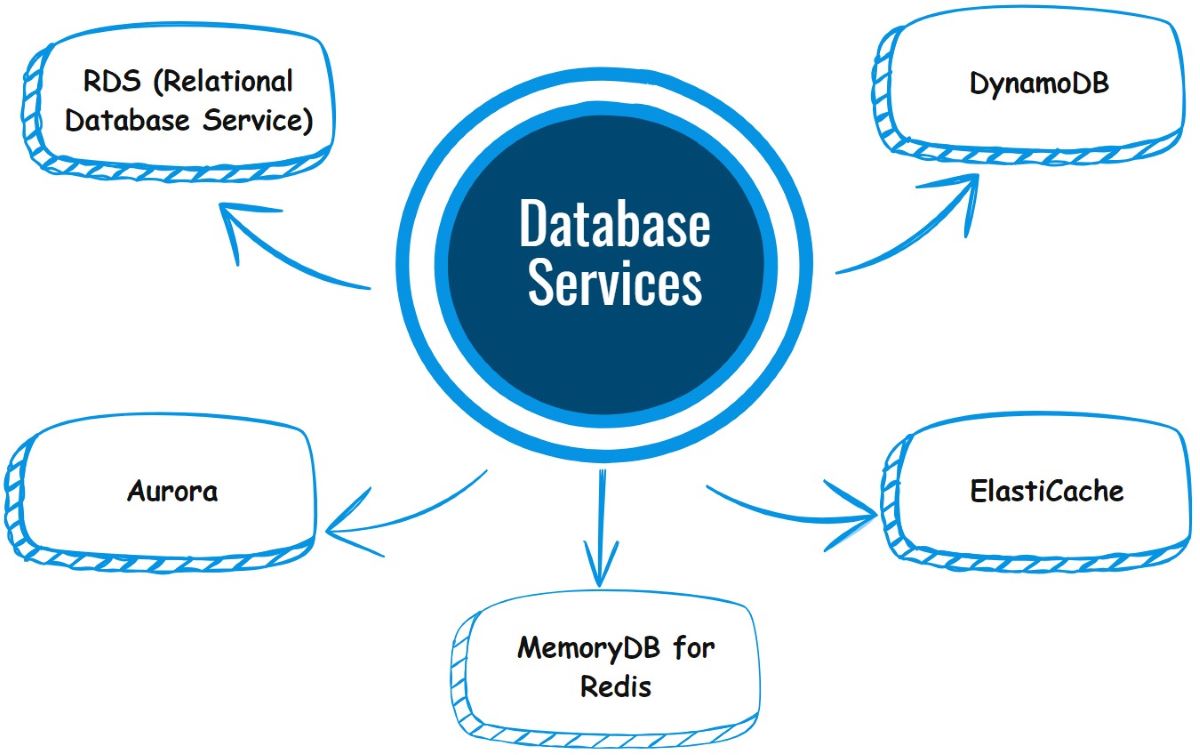Database Services
Notes about AWS Database Services

tip
You can download these notes as pdf from here.
1. Amazon RDS (Relational Database Service)
- Managed Database Service: Simplifies the setup, operation, and scaling of a relational database.
- Supported Engines: MySQL, PostgreSQL, MariaDB, Oracle, SQL Server, and Amazon Aurora.
- Multi-AZ Deployments: Provides high availability and automatic failover.
- Read Replicas: Improve read performance and scalability.
- Automated Backups: Daily backups, snapshots, and point-in-time recovery.
- Monitoring: Use CloudWatch for metrics and performance insights for detailed performance analysis.
- Security: Network isolation with VPC, encryption at rest and in transit, IAM roles for access management.
2. Amazon Aurora
- MySQL and PostgreSQL-Compatible: High performance and availability with full compatibility.
- High Availability: Automatic failover, continuous backup to S3, replication across three Availability Zones.
- Performance: 5x throughput of standard MySQL and 3x of PostgreSQL.
- Serverless Option: Scales automatically based on application needs.
- Global Databases: Enables a single database to span multiple AWS regions.
3. Amazon DynamoDB
- NoSQL Database: Fully managed, key-value and document database.
- Scalability: Automatically scales throughput capacity, offers on-demand mode for instant scaling.
- Performance: Single-digit millisecond response times.
- Data Models: Tables, items, and attributes with support for document and key-value store models.
- Indexes: Global Secondary Indexes (GSI) and Local Secondary Indexes (LSI) for query flexibility.
- DynamoDB Streams: Capture changes to items in a table for real-time processing.
- DAX: In-memory caching for DynamoDB, providing microsecond latency.
4. Amazon ElastiCache
- In-Memory Data Store: Fully managed Redis or Memcached service.
- Use Cases: Caching, session management, real-time analytics.
- Scalability: Scale-out, sharding, replication.
- High Availability: Multi-AZ with automatic failover for Redis.
- Performance: Sub-millisecond response times, high throughput.
5. Amazon MemoryDB for Redis
- Fully Managed Redis-Compatible Database: Provides Redis-compatible in-memory database service for real-time applications.
- High Availability: Multi-AZ replication with automatic failover.
- Durability: Data is replicated across multiple nodes and backed up to disk.
- Performance: Designed for high throughput and low latency.
- Security: Supports encryption at rest and in transit, VPC isolation, and IAM integration.
- Scalability: Easily scale read and write capacity to meet application demands.
Key Concepts and Best Practices
- High Availability: Implement Multi-AZ deployments and read replicas where applicable.
- Scalability: Use features like auto-scaling for DynamoDB, Aurora's serverless option, and Redshift's ability to scale compute and storage independently.
- Backup and Recovery: Regularly back up databases, use automated backups and snapshots.
- Security: Encrypt data at rest and in transit, use IAM for access control, isolate databases in VPCs.
- Monitoring and Performance: Use CloudWatch for monitoring metrics, performance insights for RDS and Aurora, and DynamoDB's performance tools.
- Cost Management: Choose the right instance types and storage options, leverage reserved instances for long-term savings, and monitor usage to avoid over-provisioning.
- Data Integrity: Use transaction management and data replication features to ensure consistency and durability.
Every Bit of Support Helps!
If you have enjoyed this post, please consider buying me a coffee ☕ to help me keep writing!